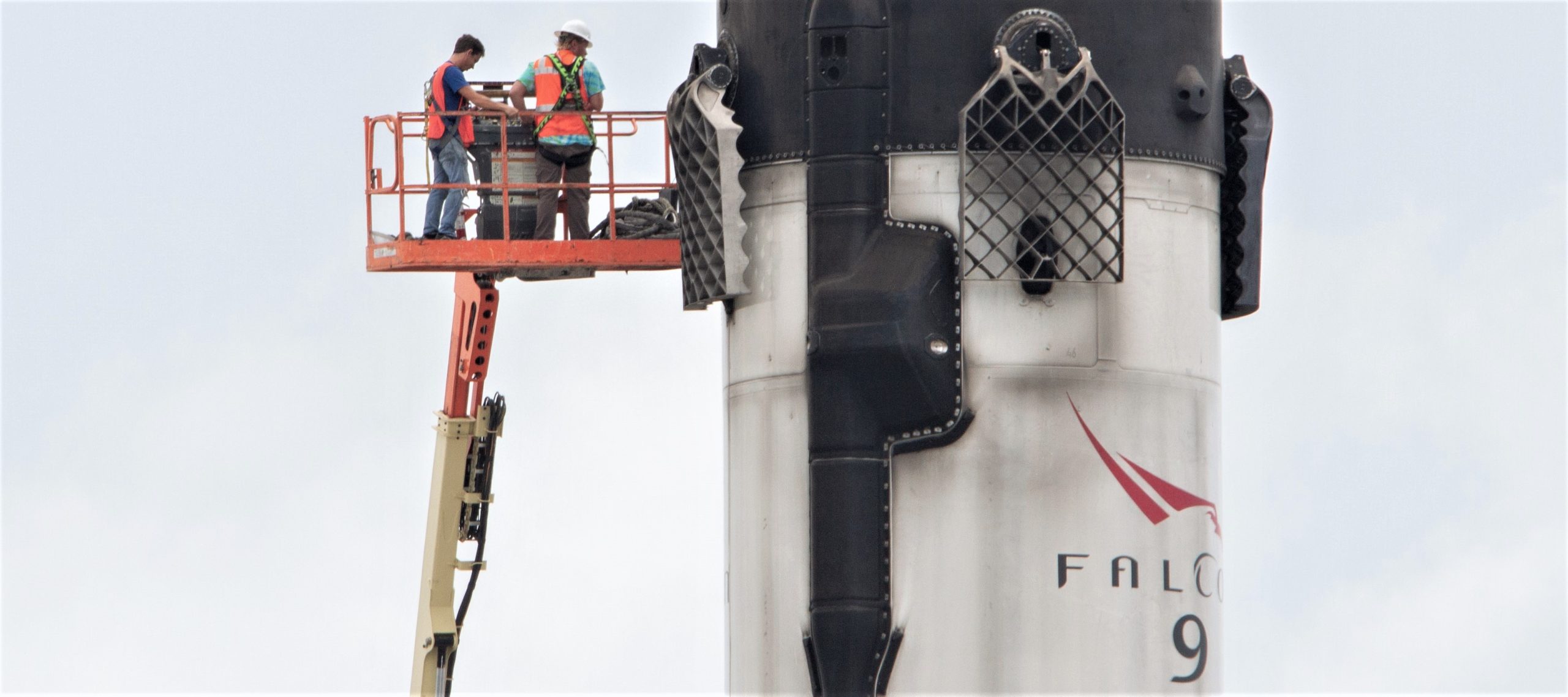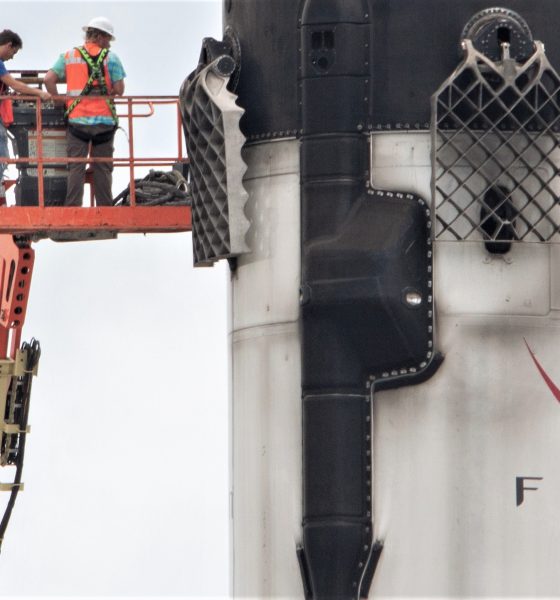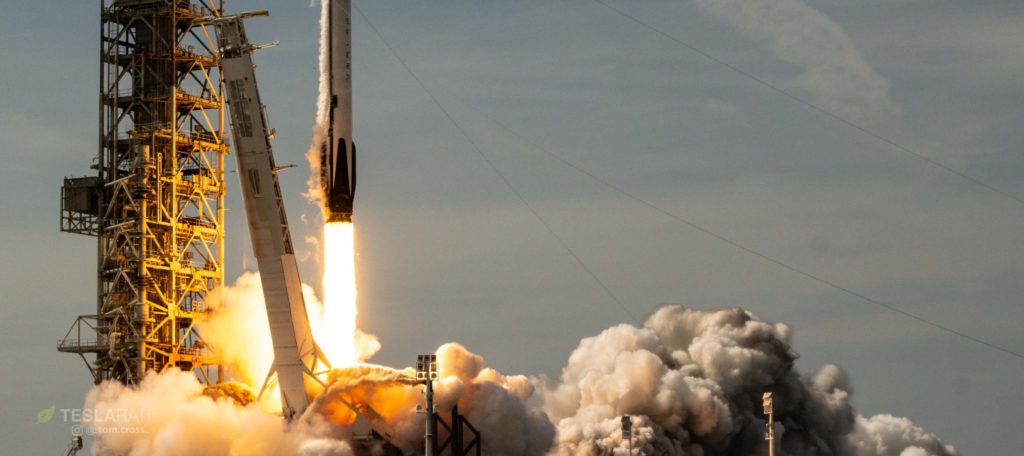

News
SpaceX’s first Falcon 9 Block 5 reuse will also be its quickest drone ship turnaround
According to observations of SpaceX booster movements at Cape Canaveral Air Force Station on July 24, it appears that the company will reuse a Falcon 9 Block 5 booster for the first time ever on August 4, just over a week from today.
Independent of the booster flying, SpaceX will also break their internal record for drone ship recovery turnaround if they manage to launch and land another rocket on the 4th, just 14 days after Of Course I Still Love You’s July 21 (EDT) booster recovery.

The Telkom 4 (Merah Putih) communications satellite will be sent by SpaceX to a geostationary transfer orbit and will become the second heaviest satellite ever launched by the company while still recovering the Falcon 9 booster, weighing in at around 5800 kg. While SpaceX’s launch and landing for the record-breaking 7080 kg Telstar 19V mission may appear more impressive at face value, it’s likely that Telkom 4 will be even more taxing for the rocket, thanks to the much higher geostationary transfer orbit the satellite will most likely be placed in.
Block 5 booster to be reused for a third launch in two weeks
This will be SpaceX’s third Falcon 9 Block 5 launch in less than two weeks if the schedule holds. More important than the schedule, perhaps, is the fact that it would appear that SpaceX intends to reuse the first Block 5 booster (B1046) for this particular launch. To lay out the foundation of this claim, it’s known that SpaceX’s CCAFS Pad 40 integration facilities are only capable of fitting one booster and the strongback (transporter/erector/launcher, TEL) at a time, evidenced both by sourced comments and views inside the hangar.
- Soon after, B1046 was spotted on its way to a refurbishment facility around a week after its May 11 launch debut. (Instagram /u/tersco)
- The second Block 5 booster, B1047, debuted at LC-40 on July 21. (Tom Cross)
Meanwhile, an unmistakeable Block 5 booster – with black interstage and octaweb coverings – was spotted being transported through Cape Canaveral Air Force Station (CCAFS) earlier this week, just after Falcon 9 B1047 launched (July 21 EDT) and freed up space for another booster inside the horizontal integration facility (HIF) at Pad 40. Given that only one Block 5 booster has been recovered on the East Coast and that B1047 was still out at sea earlier this week, the sooty booster traveling through CCAFS thus has to have been B1046, and it was making a beeline for LC-40.
Just one week before Telkom 4’s scheduled prelaunch static fire (July 31), there is no conceivable reason that SpaceX would bring a booster not immediately needed for launch into Pad 40’s HIF. As such, it can be all but guaranteed that Falcon 9 B1046 will be reflying for the first time, marking the first critical reuse of a Block 5 booster and hopefully the first of many dozens or even hundreds of reflights for the Block 5 fleet over the next several years.
Autonomous drone ship Of Course I Still Love You arrived at Port Canaveral with Falcon booster B1047 in tow around dawn, July 25. Since then, the booster has been offloaded onto SpaceX’s Port Canaveral berth space and is perched atop its stand while crews of technicians and engineers have focused on its legs. It appears that they may be removing them outright, but the fact that nothing has been visibly removed at this point suggests that there is still a chance of leg retraction, an important Block 5 upgrade required for truly rapid reusability. It also appears to be the debut of a brand new connection apparatus at the top of the interstage, purpose likely related in some way to leg retraction.
Duo of cherry pickers loaded w/techs attaching guidewires atop #Falcon9 booster w completely newfangled hoisting cap/rectangular brace installed in place.1st use above sleek black Ti grid fins-on 2nd ever @SpaceX #Block5 for #Telstar19V launch. @ken_kremer https://t.co/G4fyocB13Q pic.twitter.com/qhnYcugWxb
— Ken Kremer🇺🇦🇩🇪🇺🇸🚀🧪 (@ken_kremer) July 27, 2018
Stay tuned for more updates and official visual confirmation as SpaceX tracks towards a July 31/Aug 1 static fire for the booster and a Telkom 4 launch date of no earlier than August 4, 1:19 am EDT/05:19 UTC.
For prompt info, on-the-ground perspectives, and unique glimpses of SpaceX’s rocket recovery fleet (including fairing catcher Mr Steven) check out our brand new LaunchPad and LandingZone newsletters!

News
Tesla FSD fleet is nearing 7 billion total miles, including 2.5 billion city miles
As can be seen on Tesla’s official FSD webpage, vehicles equipped with the system have now navigated over 6.99 billion miles.

Tesla’s Full Self-Driving (Supervised) fleet is closing in on almost 7 billion total miles driven, as per data posted by the company on its official FSD webpage.
These figures hint at the massive scale of data fueling Tesla’s rapid FSD improvements, which have been quite notable as of late.
FSD mileage milestones
As can be seen on Tesla’s official FSD webpage, vehicles equipped with the system have now navigated over 6.99 billion miles. Tesla owner and avid FSD tester Whole Mars Catalog also shared a screenshot indicating that from the nearly 7 billion miles traveled by the FSD fleet, more than 2.5 billion miles were driven inside cities.
City miles are particularly valuable for complex urban scenarios like unprotected turns, pedestrian interactions, and traffic lights. This is also the difference-maker for FSD, as only complex solutions, such as Waymo’s self-driving taxis, operate similarly on inner-city streets. And even then, incidents such as the San Francisco blackouts have proven challenging for sensor-rich vehicles like Waymos.
Tesla’s data edge
Tesla has a number of advantages in the autonomous vehicle sector, one of which is the size of its fleet and the number of vehicles training FSD on real-world roads. Tesla’s nearly 7 billion FSD miles then allow the company to roll out updates that make its vehicles behave like they are being driven by experienced drivers, even if they are operating on their own.
So notable are Tesla’s improvements to FSD that NVIDIA Director of Robotics Jim Fan, after experiencing FSD v14, noted that the system is the first AI that passes what he described as a “Physical Turing Test.”
“Despite knowing exactly how robot learning works, I still find it magical watching the steering wheel turn by itself. First it feels surreal, next it becomes routine. Then, like the smartphone, taking it away actively hurts. This is how humanity gets rewired and glued to god-like technologies,” Fan wrote in a post on X.
News
Tesla starts showing how FSD will change lives in Europe
Local officials tested the system on narrow country roads and were impressed by FSD’s smooth, human-like driving, with some calling the service a game-changer for everyday life in areas that are far from urban centers.

Tesla has launched Europe’s first public shuttle service using Full Self-Driving (Supervised) in the rural Eifelkreis Bitburg-Prüm region of Germany, demonstrating how the technology can restore independence and mobility for people who struggle with limited transport options.
Local officials tested the system on narrow country roads and were impressed by FSD’s smooth, human-like driving, with some calling the service a game-changer for everyday life in areas that are far from urban centers.
Officials see real impact on rural residents
Arzfeld Mayor Johannes Kuhl and District Administrator Andreas Kruppert personally tested the Tesla shuttle service. This allowed them to see just how well FSD navigated winding lanes and rural roads confidently. Kruppert said, “Autonomous driving sounds like science fiction to many, but we simply see here that it works totally well in rural regions too.” Kuhl, for his part, also noted that FSD “feels like a very experienced driver.”
The pilot complements the area’s “Citizen Bus” program, which provides on-demand rides for elderly residents who can no longer drive themselves. Tesla Europe shared a video of a demonstration of the service, highlighting how FSD gives people their freedom back, even in places where public transport is not as prevalent.
What the Ministry for Economic Affairs and Transport says
Rhineland-Palatinate’s Minister Daniela Schmitt supported the project, praising the collaboration that made this “first of its kind in Europe” possible. As per the ministry, the rural rollout for the service shows FSD’s potential beyond major cities, and it delivers tangible benefits like grocery runs, doctor visits, and social connections for isolated residents.
“Reliable and flexible mobility is especially vital in rural areas. With the launch of a shuttle service using self-driving vehicles (FSD supervised) by Tesla in the Eifelkreis Bitburg-Prüm, an innovative pilot project is now getting underway that complements local community bus services. It is the first project of its kind in Europe.
“The result is a real gain for rural mobility: greater accessibility, more flexibility and tangible benefits for everyday life. A strong signal for innovation, cooperation and future-oriented mobility beyond urban centers,” the ministry wrote in a LinkedIn post.
News
Tesla China quietly posts Robotaxi-related job listing
Tesla China is currently seeking a Low Voltage Electrical Engineer to work on circuit board design for the company’s autonomous vehicles.

Tesla has posted a new job listing in Shanghai explicitly tied to its Robotaxi program, fueling speculation that the company is preparing to launch its dedicated autonomous ride-hailing service in China.
As noted in the listing, Tesla China is currently seeking a Low Voltage Electrical Engineer to work on circuit board design for the company’s autonomous vehicles.
Robotaxi-specific role
The listing, which was shared on social media platform X by industry watcher @tslaming, suggested that Tesla China is looking to fill the role urgently. The job listing itself specifically mentions that the person hired for the role will be working on the Low Voltage Hardware team, which would design the circuit boards that would serve as the nervous system of the Robotaxi.
Key tasks for the role, as indicated in the job listing, include collaboration with PCB layout, firmware, mechanical, program management, and validation teams, among other responsibilities. The role is based in Shanghai.
China Robotaxi launch
China represents a massive potential market for robotaxis, with its dense urban centers and supportive policies in select cities. Tesla has limited permission to roll out FSD in the country, though despite this, its vehicles have been hailed as among the best in the market when it comes to autonomous features. So far, at least, it appears that China supports Tesla’s FSD and Robotaxi rollout.
This was hinted at in November, when Tesla brought the Cybercab to the 8th China International Import Expo (CIIE) in Shanghai, marking the first time that the autonomous two-seater was brought to the Asia-Pacific region. The vehicle, despite not having a release date in China, received a significant amount of interest among the event’s attendees.











